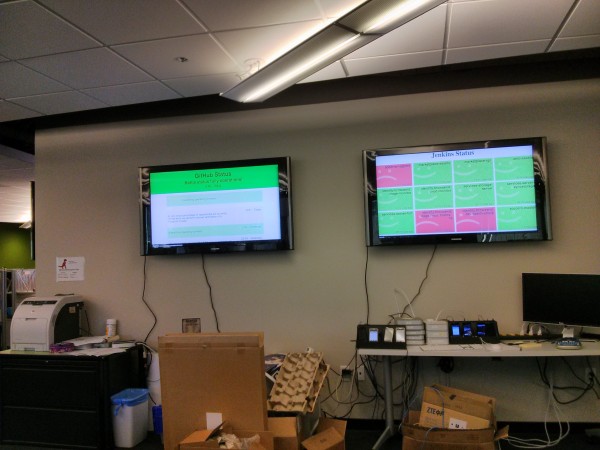Crimson Twins is a project that I started at Mozilla to power two ambient
displays that we mounted on the wall in the Mountain View Mozilla office. We
use it to show dashboards, such as the current status of the sprint or the state of GitHub. We also use it to share useful sites, such as posting a YouTube video that is related to the current conversation. Most of the time that I pay attention to the Twins, is when my coworkers and I post amusing animated GIFs to distract amuse the rest of the office.
Technical Details
Crimson Twins is a Node.JS app that is currently running on Mozilla’s internal PaaS, an instance of Stackato. It uses Socket.io for real time two way communication between the server and the client. Socket.io uses WebSockets, long polling, Flash sockets, or a myriad of other techniques.
The architecture of the system is that there are a small number of virtual screens, which represent targets to send content to. Each client connected to the server can choose one or more of these virtual screens to display. A client can be any modern web browser, and I have used Firefox for Desktop and Android, Safari on iOS, and Chrome on desktop without any trouble.
Because of this setup, remote Mozillians can connect to the server and load up the same things that are shown on the TVs in the office. Put another way, Crimson Twins is remotie friendly, and people can play along at home.
Content Handling
Content is displayed with one of two mechanisms. For images, the content is loaded as a background of a div. Originally img tags were used, but it was difficult to style them this way. The switch to divs made it much easier to zoom the image to full screen without using JavaScript.
For content that is not images, a sandboxed iframe is used. This allows most sites to be shown with Crimson Twins, and the sandboxing prevents malicious sites from hijacking the Crimson Twins container1. This means that sites that disallow framing cannot be used with the system, but after much brainstorming we have yet to find a satisfactory way to get around this. Luckily most sites don’t worry about iframes, so this isn’t normally a huge annoyance.
For every URL that is sent to the screens, the sever first makes a HEAD request to the requested resource. A few things happen with this information. First, it is used to determine if the URL is an image or not, by examining content type. Second, it examines the headers to find things, such as X-Frames-Options: deny, server errors, or malformed URLs; it provides useful error messages if something like this happens.
Additionally, the requested URLs can go through various transformations. For example, if a link to an Imgur page is posted, the server will transform the URL into the URL for the image on the page. A link to an XKCD comic page will query the XKCD API for the URL of the image for that comic. This mechanism also allows for black listing of various content.

CT displaying an XKCD comic. URL transformations can automatically reformat known sites for a better view.
What’s with the name?
The name of the project is a little silly, and is (I’m told) a reference to the old G.I. Joe cartoons. One of the enemies in the show were the twins Tomax and Xamot, collectively known as the Crimson Twins. It was proposed humorously, but I decided to keep it, and now I rarely think about the cartoon series anymore.
It has enough related names that the related projects that have sprung up have been easy to name, such as the Crimson Guard Commanders, the IRC name for one of the bots that interfaces with the API; and Extensive Enterprises, a web based camera-to-Imgur-to-IRC-to-CrimsonTwins roundabout way to post photos to the screens.
The Future
Crimson Twins has been proposed to be used as ambient displays in the public areas of various Mozilla offices, and as a general purpose manager for driving screens. To this end it is probably going to grow features such as remote control of clients, a more powerful API, and features to make it easy to manage remotely.
CrimsonTwins is open source, and can be found on GitHub. Pull requests are welcome, and if you want to chat about it, you can find me as mythmon in #bots on irc.mozilla.org.
- Due to bug 785310, Firefox allows sandboxed iframes with scripts enabled to directly access the parent document, which is a violation of the spec. Hopefully this bug will be fixed in the near future. ↩
